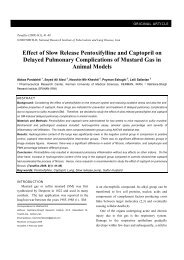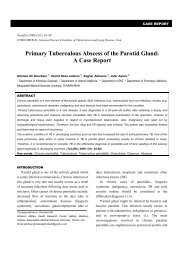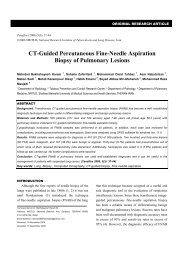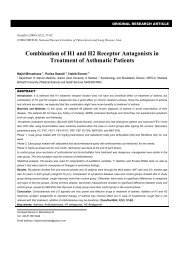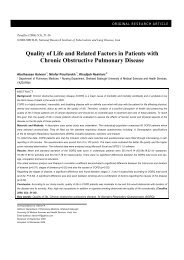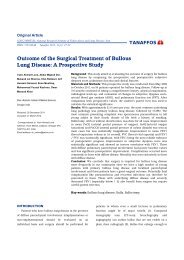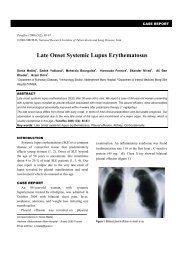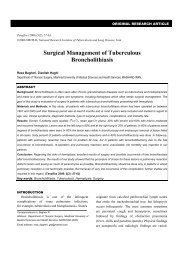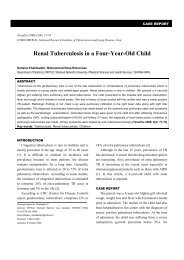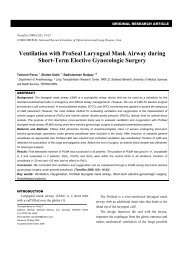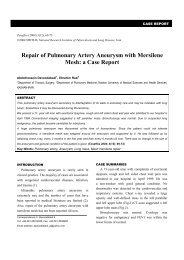Diagnostic Value of Lung CT-Scan in Childhood ... - Tanaffos
Diagnostic Value of Lung CT-Scan in Childhood ... - Tanaffos
Diagnostic Value of Lung CT-Scan in Childhood ... - Tanaffos
You also want an ePaper? Increase the reach of your titles
YUMPU automatically turns print PDFs into web optimized ePapers that Google loves.
ORIGINAL RESEARCH ARTICLE<br />
<strong>Tanaffos</strong> (2005) 4(16), 57-62<br />
©2005 NRITLD, National Research Institute <strong>of</strong> Tuberculosis and <strong>Lung</strong> Disease, Iran<br />
<strong>Diagnostic</strong> <strong>Value</strong> <strong>of</strong> <strong>Lung</strong> <strong>CT</strong>-<strong>Scan</strong> <strong>in</strong> <strong>Childhood</strong><br />
Tuberculosis<br />
Noosh<strong>in</strong> Baghaie 1 , Mehrdad Bakhshayesh Karam 2 , Soheila Khalilzadeh 1 , Siamak Arami 1 , Mohammad<br />
Reza Masjedi 3 and Ali Akbar Velayati 1<br />
1Department <strong>of</strong> Pediatrics, 2 Department <strong>of</strong> Radiology, 3 Department <strong>of</strong> Pulmonary Medic<strong>in</strong>e, NRITLD, Shaheed Beheshti University <strong>of</strong><br />
Medical Sciences and Health Services, TEHRAN-IRAN<br />
ABSTRA<strong>CT</strong><br />
Background: Many different methods and approaches have been applied for confirmation <strong>of</strong> tuberculosis <strong>in</strong> children. The<br />
diagnostic criteria be<strong>in</strong>g currently used for detection <strong>of</strong> childhood TB consist <strong>of</strong> cl<strong>in</strong>ical symptoms, history <strong>of</strong> close contact,<br />
radiological f<strong>in</strong>d<strong>in</strong>gs, PPD test and positive bacteriologic or pathologic f<strong>in</strong>d<strong>in</strong>gs. S<strong>in</strong>ce each <strong>of</strong> these methods may have false<br />
positive or negative results, it is necessary to f<strong>in</strong>d a better method for prompt diagnosis. This study was performed to<br />
determ<strong>in</strong>e the value <strong>of</strong> <strong>CT</strong>-scan as a sensitive method <strong>in</strong> detect<strong>in</strong>g hilar, parenchymal and mediast<strong>in</strong>al <strong>in</strong>volvements <strong>in</strong> early<br />
diagnsis <strong>of</strong> childhood TB and compare it with other diagnostic criteria.<br />
Materials and Methods: This cross-sectional comparative study was carried out on 100 children, suspicious <strong>of</strong> hav<strong>in</strong>g<br />
primary pulmonary TB between September 1999 and September 2000 <strong>in</strong> Masih Daneshvari Hospital. All patients had prior<br />
history <strong>of</strong> close contact with smear-positive patients hav<strong>in</strong>g active pulmonary TB. Epidemiological factors as well as<br />
radiological and microbiological f<strong>in</strong>d<strong>in</strong>gs were evaluated.<br />
Results: Of total 100 patients, 43 were female and 57 were male. The mean age was 7.5 ± 3.6 yrs rang<strong>in</strong>g from 4 months to<br />
14 years. Forty two were Iranian and 58 were Afghan. Thirty n<strong>in</strong>e children had a positive PPD test. Bacteriological and simple<br />
chest x ray f<strong>in</strong>d<strong>in</strong>gs compatible with TB were positive <strong>in</strong> 11 and 36 patients, respectively. Pulmonary <strong>CT</strong>-scan without<br />
contrast revealed lung lesions <strong>in</strong> 55 patients while 25 <strong>of</strong> them (45.4%) had normal chest x rays. In 12 patients positive <strong>CT</strong>scan<br />
was the only positive diagnostic f<strong>in</strong>d<strong>in</strong>g.<br />
Conclusion: Our results show the value <strong>of</strong> pulmonary <strong>CT</strong>-scan as a diagnostic criterion <strong>in</strong> pediatiric tuberculosis and we<br />
recommend it for early diagnosis <strong>in</strong> suspicious cases with no other positive f<strong>in</strong>d<strong>in</strong>gs. (<strong>Tanaffos</strong> 2005; 4(16): 57-62)<br />
Key words: Tuberculosis, <strong>Childhood</strong>, <strong>CT</strong>-scan<br />
INTRODU<strong>CT</strong>ION<br />
Tuberculosis is a major cause <strong>of</strong> morbidity and<br />
mortality <strong>of</strong> children <strong>in</strong> develop<strong>in</strong>g countries.<br />
Although <strong>in</strong>cidence <strong>of</strong> TB <strong>in</strong> developed countries<br />
Correspondence to: Baghaie N<br />
Address: NRITLD, Shaheed Bahonar Ave, Darabad, TEHRAN<br />
19569, P.O:19575/154, IRAN<br />
Email address: nbbaghaie@nritld.ac.ir<br />
was descend<strong>in</strong>g till the previous two decades, this<br />
rate is <strong>in</strong>creas<strong>in</strong>g s<strong>in</strong>ce 1985 due to various reasons<br />
such as <strong>in</strong>creased prevalence <strong>of</strong> HIV, immigration,<br />
poverty and homelessness. Prevalence rate <strong>of</strong> TB <strong>in</strong><br />
children had a 34% <strong>in</strong>crease dur<strong>in</strong>g 1985-1992 (1).<br />
Accord<strong>in</strong>g to WHO report, 13 million new cases
58 <strong>Lung</strong> <strong>CT</strong>-<strong>Scan</strong> <strong>in</strong> <strong>Childhood</strong> Tuberculosis<br />
<strong>of</strong> TB and 5 million deaths due to tuberculosis were<br />
detected <strong>in</strong> children under 15 years <strong>of</strong> age dur<strong>in</strong>g<br />
1990-2000 (2).<br />
Children are at great risk <strong>of</strong> be<strong>in</strong>g <strong>in</strong>fected with<br />
this disease. Diagnosis and treatment <strong>of</strong> TB <strong>in</strong><br />
childhood period can prevent the progressive form <strong>in</strong><br />
children (tuberculous men<strong>in</strong>gitis and miliary TB) and<br />
active TB <strong>in</strong> adults (2, 3).<br />
Diagnosis <strong>of</strong> TB <strong>in</strong> children is difficult as the<br />
result <strong>of</strong> absence <strong>of</strong> specific cl<strong>in</strong>ical symptoms and<br />
pauci-bacilli <strong>in</strong> this period (4).<br />
Us<strong>in</strong>g more accurate and simple methods <strong>of</strong><br />
imag<strong>in</strong>g such as lung <strong>CT</strong>-scan can result <strong>in</strong> a more<br />
accurate diagnosis (5).<br />
In a retrospective study performed <strong>in</strong> 1995 on 14<br />
children suspicions <strong>of</strong> hav<strong>in</strong>g TB with normal chest x<br />
ray and lung <strong>CT</strong>-scan, primary lesion was detected <strong>in</strong><br />
8 children (6).<br />
In another study <strong>in</strong> 1997, primary tuberculotic<br />
lesions were detected by perform<strong>in</strong>g high resolution<br />
<strong>CT</strong>-scan on 27 children suspicious <strong>of</strong> hav<strong>in</strong>g TB (7).<br />
This study was conducted to determ<strong>in</strong>e the value<br />
<strong>of</strong> lung <strong>CT</strong>-scan <strong>in</strong> prompt and early diagnosis <strong>of</strong><br />
primary tuberculotic lesions <strong>in</strong> children suspicious <strong>of</strong><br />
hav<strong>in</strong>g TB and compare it with other diagnostic<br />
criteria.<br />
MATERIALS AND METHODS<br />
This was a cross-sectional comparative study<br />
performed on 100 children at the age range <strong>of</strong> 4<br />
months to 14 yrs who were referred to pediatric ward<br />
<strong>of</strong> NRITLD for exam<strong>in</strong>ation, hav<strong>in</strong>g history <strong>of</strong> close<br />
contact with a smear- positive TB patient.<br />
All children under study were exam<strong>in</strong>ed by a<br />
paediatrician and all the required data along with the<br />
history, cl<strong>in</strong>ical exam<strong>in</strong>ation, relationship <strong>of</strong> child<br />
with the TB patient, duration <strong>of</strong> time be<strong>in</strong>g <strong>in</strong> contact<br />
with the TB patient and history <strong>of</strong> BCG vacc<strong>in</strong>ation<br />
were recorded <strong>in</strong> special forms.<br />
All the referred children were hospitalized for<br />
gastric lavage culture. At least three samples <strong>of</strong><br />
gastric lavage or sputum were sent for direct smear<br />
exam<strong>in</strong>ation, Ziehl Neelsen sta<strong>in</strong><strong>in</strong>g, and culture. For<br />
all patients PPD test was performed as <strong>in</strong>ject<strong>in</strong>g a 5-<br />
unit tubercul<strong>in</strong> as 0.1 cc <strong>in</strong> anterior part <strong>of</strong> the<br />
forearm and evaluat<strong>in</strong>g the result after 48-72 hours<br />
measur<strong>in</strong>g the diameter <strong>of</strong> <strong>in</strong>duration.<br />
Simple chest x-ray (PA and lateral view) and<br />
chest <strong>CT</strong>-scan were obta<strong>in</strong>ed <strong>of</strong> all children (<strong>in</strong> 3<br />
days after hospitalization without <strong>in</strong>ject<strong>in</strong>g the<br />
contract media) us<strong>in</strong>g Siemens Somatom Plus device<br />
Results <strong>of</strong> the <strong>CT</strong>-scan and chest x-ray were<br />
evaluated simultaneously by a radiologist. In some<br />
cases lung <strong>CT</strong>-scan with <strong>in</strong>jection or HR<strong>CT</strong> was<br />
recommended if needed. Simple chest x-ray and lung<br />
<strong>CT</strong>-scan results along with other f<strong>in</strong>d<strong>in</strong>gs and<br />
diagnostic criteria were evaluated statistically us<strong>in</strong>g<br />
chi-square, and P-value, and then sensitivity and<br />
specifity <strong>of</strong> them were calculated.<br />
RESULTS<br />
Of a total <strong>of</strong> 100 patients, 57 (57%) were male<br />
and 43(43%) were female. Patients were at the age<br />
range <strong>of</strong> 4 months to 14 years and the mean age was<br />
7.5 yrs. 42% were Iranian and 58% were Afghan.<br />
Fifty-one percent <strong>of</strong> patients had a history <strong>of</strong> BCG<br />
vacc<strong>in</strong>ation.<br />
All children had a history <strong>of</strong> close contact with a<br />
smear positive TB patient (a family member). The<br />
TB patient was the father <strong>in</strong> 38%, the mother <strong>in</strong> 30%,<br />
brother <strong>in</strong> 7%, sister <strong>in</strong> 5% and <strong>of</strong> other relatives <strong>in</strong><br />
20% <strong>of</strong> the cases.<br />
Cl<strong>in</strong>ical symptoms were present <strong>in</strong> only 10<br />
children (10%) <strong>in</strong>clud<strong>in</strong>g failure to thrive (FTT) <strong>in</strong> 4<br />
patients, cough <strong>in</strong> 4 patients and prolonged fever <strong>in</strong> 2<br />
patients. PPD test was positive <strong>in</strong> 39 patients (39%).<br />
Induration was exam<strong>in</strong>ed consider<strong>in</strong>g history <strong>of</strong> BCG<br />
vacc<strong>in</strong>ation (<strong>in</strong> case <strong>of</strong> positive history <strong>of</strong><br />
<strong>Tanaffos</strong> 2005; 4(16):57-62
Baghaie N, et al. 59<br />
vacc<strong>in</strong>ation, <strong>in</strong>duration ≥15 mm and <strong>in</strong> case <strong>of</strong><br />
negative history, <strong>in</strong>duration ≥10 mm was considered<br />
as positive).<br />
In simple chest x-ray, positive f<strong>in</strong>d<strong>in</strong>gs were<br />
present <strong>in</strong> 36 patients (36%) (Table 1). There was no<br />
positive f<strong>in</strong>d<strong>in</strong>g <strong>in</strong> chest x-ray <strong>of</strong> 64 patients (64%).<br />
Table 1. Radiologic f<strong>in</strong>d<strong>in</strong>gs <strong>in</strong> simple chest X rays <strong>of</strong> 100 children<br />
suspicious <strong>of</strong> hav<strong>in</strong>g primary pulmonary TB <strong>in</strong> Masih Daneshvari<br />
hospital 1999-2000.<br />
Type <strong>of</strong> <strong>in</strong>volvement<br />
Number (Percentage)<br />
Hilar adenopathy 16 (16%)<br />
Parenchymal <strong>in</strong>filtration 6 (6%)<br />
Calcification 6(6%)<br />
Hilar adenopathy+ Parenchymal <strong>in</strong>filtration 4(4%)<br />
Hilar adenopathy+ Calcification 4(4%)<br />
Total 36 (36%)<br />
Mycobacteriologic evaluation results were<br />
positive only <strong>in</strong> 11 patients (11%) out <strong>of</strong> which<br />
smear and culture were both positive <strong>in</strong> 2, smear was<br />
positive and culture was negative <strong>in</strong> 4, and smear was<br />
negative and culture was positive <strong>in</strong> 5 cases.<br />
Abnormal f<strong>in</strong>d<strong>in</strong>gs were found <strong>in</strong> lung <strong>CT</strong>-scan <strong>of</strong><br />
55% <strong>of</strong> patients. Chest x-ray was abnormal <strong>in</strong> 30<br />
(54.5%) and normal <strong>in</strong> 25 (45.5%) <strong>of</strong> them.<br />
In 39 patients chest x ray and lung <strong>CT</strong>-scan were<br />
both normal.<br />
In 6 patients, lung <strong>CT</strong>-scan was normal whereas<br />
chest x-ray had shown <strong>in</strong>volvements. Abnormal<br />
f<strong>in</strong>d<strong>in</strong>gs <strong>in</strong> lung <strong>CT</strong>-scan <strong>of</strong> patients are<br />
demonstrated <strong>in</strong> table 2. The most prevalent positive<br />
f<strong>in</strong>d<strong>in</strong>g was hilar adenopathy <strong>of</strong> the right lung (22%).<br />
Gastric lavage culture became positive after 2<br />
months <strong>in</strong> 2 children <strong>in</strong> whom lung <strong>CT</strong>-scan showed<br />
the lesion with no other positive f<strong>in</strong>d<strong>in</strong>g.<br />
HR<strong>CT</strong> was obta<strong>in</strong>ed <strong>in</strong> 5 patients. In 3 cases,<br />
bronchiectasis; <strong>in</strong> one case, miliary tuberculosis; and<br />
<strong>in</strong> another one cavity were seen <strong>in</strong> the lung.<br />
Table 2. Abnormal f<strong>in</strong>d<strong>in</strong>gs <strong>in</strong> lung <strong>CT</strong>-scan <strong>of</strong> 100 children suspicious<br />
<strong>of</strong> hav<strong>in</strong>g primary pulmonary TB.<br />
Abnormal f<strong>in</strong>d<strong>in</strong>gs<br />
Number<br />
Hilar adenopathy <strong>of</strong> the right lung 22<br />
Parenchymal <strong>in</strong>filtration+ Adenopathy 19<br />
Calcification+ Adenopathy 17<br />
Hilar adenopathy <strong>of</strong> the left lung 13<br />
Calcification 7<br />
Parenchymal <strong>in</strong>filtration 5<br />
Bronchiectasis 4<br />
Parenchymal <strong>in</strong>filtration 5<br />
Paratracheal adenoapthy 2<br />
Mediast<strong>in</strong>al adenopathy 1<br />
Cavity 1<br />
Miliary 1<br />
In lung <strong>CT</strong>-scan with contrast, 3 cases <strong>of</strong><br />
mediast<strong>in</strong>al and paratracheal adenopathy and 2 cases<br />
<strong>of</strong> hilar adenopathy as low attenuation nodes with<br />
rim enhancement were reported.<br />
Comparison <strong>of</strong> <strong>CT</strong>-scan results with all diagnostic<br />
criteria, presence <strong>of</strong> 3 out <strong>of</strong> 4 criteria (contact<br />
history, cl<strong>in</strong>ical symptoms, radiology and tubercul<strong>in</strong><br />
test) or presence <strong>of</strong> positive bacteriologic results with<br />
another criterion <strong>in</strong>dicated 100% sensitivity and 40%<br />
specificity. Comparison <strong>of</strong> positive and negative<br />
f<strong>in</strong>d<strong>in</strong>gs <strong>of</strong> lung <strong>CT</strong>-scan with PPD, cl<strong>in</strong>ical<br />
symptoms and bacteriologic test results are shown <strong>in</strong><br />
table 3, 4 and 5 respectively.<br />
Table 3. Comparison <strong>of</strong> positive and negative fid<strong>in</strong>gs <strong>in</strong> <strong>CT</strong>-scan with<br />
PPD <strong>of</strong> 100 chidlren suspicious <strong>of</strong> hav<strong>in</strong>g primary pulmonary Tb <strong>in</strong><br />
Masih Daneshvari hospital- 1999-2000.<br />
<strong>CT</strong>-scan<br />
PPD<br />
Positive Negative<br />
Positive 34 5<br />
Negative 21 40<br />
<strong>Tanaffos</strong> 2005; 4(16):57-62
60 <strong>Lung</strong> <strong>CT</strong>-<strong>Scan</strong> <strong>in</strong> <strong>Childhood</strong> Tuberculosis<br />
Table 4. Comparison <strong>of</strong> positive and negative f<strong>in</strong>d<strong>in</strong>gs <strong>in</strong> lung <strong>CT</strong>-scan<br />
with cl<strong>in</strong>ical symptoms <strong>in</strong> 100 children suspicious <strong>of</strong> hav<strong>in</strong>g primary<br />
pulmonary TB.<br />
<strong>CT</strong>-scan<br />
Positive Negative<br />
PPD<br />
Positive 10 0<br />
Negative 45 45<br />
Table 5. Comparison <strong>of</strong> positive and negative f<strong>in</strong>dngs <strong>in</strong> lung <strong>CT</strong>-scan<br />
with mycobacteriologic tests reaults <strong>in</strong> 100 children suspicious <strong>of</strong> hav<strong>in</strong>g<br />
primary pulmonary TB.<br />
<strong>CT</strong>-scan<br />
Positive Negative<br />
PPD<br />
Positive 11 0<br />
Negative 44 45<br />
DISCUSSION<br />
There are five diagnostic criteria <strong>in</strong> diagnos<strong>in</strong>g<br />
childhood tuberculosis <strong>in</strong>clud<strong>in</strong>g: positive contact<br />
history, cl<strong>in</strong>ical symptoms, chest radiography,<br />
microbiologic f<strong>in</strong>d<strong>in</strong>gs, and tubercul<strong>in</strong> test. In this<br />
study, we evaluated the role <strong>of</strong> <strong>CT</strong>-scan as an<br />
accurate and quick way <strong>in</strong> detect<strong>in</strong>g parenchymal and<br />
mediast<strong>in</strong>al lesions <strong>in</strong> TB.<br />
In 55% <strong>of</strong> patients there were f<strong>in</strong>d<strong>in</strong>gs reveal<strong>in</strong>g<br />
pulmonary <strong>in</strong>volvement <strong>in</strong> their <strong>CT</strong>-scan. This figure<br />
<strong>in</strong>dicates that lung <strong>CT</strong>-scan has been positive <strong>in</strong> more<br />
than half <strong>of</strong> the patients. In 12 cases, it was the only<br />
positive factor except contact history. In other cases,<br />
there were more than one positive factors.<br />
In a retrospective study by Kim et al., <strong>in</strong> South<br />
Korea <strong>in</strong> 1997, 41 children with TB, diagnosed with<br />
bacteriologic f<strong>in</strong>d<strong>in</strong>gs and chest x-ray were<br />
evaluated. Results <strong>of</strong> the lung <strong>CT</strong>-scan with contrast<br />
revealed hilar and mediast<strong>in</strong>al <strong>in</strong>volvement <strong>in</strong> 90% <strong>of</strong><br />
patients (8). In another study by Katakura et al. <strong>in</strong><br />
1999 <strong>in</strong> Japan, <strong>in</strong> 5 children under 6 years old<br />
suspicious <strong>of</strong> hav<strong>in</strong>g TB, normal chest x ray, lung<br />
<strong>CT</strong>-scan with contrast was obta<strong>in</strong>ed. In all 5 children,<br />
there were evidences <strong>of</strong> <strong>in</strong>volvement as hilar<br />
adenopathy (9).<br />
In comparison with this study, <strong>in</strong> regard to type <strong>of</strong><br />
<strong>in</strong>volvement the most common f<strong>in</strong>d<strong>in</strong>g was hilar<br />
adenopathy which was observed <strong>in</strong> 70% <strong>of</strong> patients,<br />
while this f<strong>in</strong>d<strong>in</strong>g was revealed <strong>in</strong> simple chest x ray<br />
<strong>of</strong> only 40% <strong>of</strong> them.<br />
This f<strong>in</strong>d<strong>in</strong>g (presence <strong>of</strong> adenopathy) is <strong>in</strong> accord<br />
with other studies, regard<strong>in</strong>g primary childhood TB<br />
manifestations <strong>in</strong> <strong>CT</strong>-scan (8, 9, 10).<br />
Results <strong>of</strong> this study <strong>in</strong>dicated that <strong>in</strong> 55.4% <strong>of</strong><br />
patients chest x ray and lung <strong>CT</strong>-scan were both<br />
abnormal. In 45.5% <strong>of</strong> cases chest x ray was normal<br />
but lung <strong>CT</strong>-scan clearly detected the lesion.<br />
Therefore, a normal chest x ray at <strong>in</strong>itial stages <strong>of</strong><br />
disease does not rule out primary childhood TB, and<br />
by perform<strong>in</strong>g <strong>CT</strong>-scan, primary lesion may be<br />
revealed (11).<br />
In 6 patients, chest x ray was abnormal while lung<br />
<strong>CT</strong>-scan was reported to be normal. Out <strong>of</strong> these 6<br />
patients, 4 were <strong>in</strong>fants under one year <strong>of</strong> age <strong>in</strong><br />
whom <strong>CT</strong>-scan was feasible only under general<br />
anesthesia but was performed without anesthesia as<br />
the result <strong>of</strong> parent's disagreement, so the results<br />
were not reliable.<br />
Accord<strong>in</strong>g to radiologist, <strong>in</strong> 2 cases, <strong>CT</strong>-scan with<br />
contrast was necessary which was performed without<br />
it. Therefore, these 6 cases can not be used <strong>in</strong><br />
disprov<strong>in</strong>g the value <strong>of</strong> <strong>CT</strong>-scan <strong>in</strong> early diagnosis <strong>of</strong><br />
disease.<br />
<strong>Lung</strong> <strong>CT</strong>-scan can show parenchymal<br />
<strong>in</strong>volvement details precisely (12).<br />
In 3 cases <strong>of</strong> the understudy population,<br />
bronchiectasis was detected through HR<strong>CT</strong>, which<br />
was not detectable <strong>in</strong> simple chest x ray. In a study<br />
performed on 48 patients <strong>in</strong>clud<strong>in</strong>g children and<br />
adults, HR<strong>CT</strong> was used to evaluate the presence and<br />
<strong>Tanaffos</strong> 2005; 4(16):57-62
Baghaie N, et al. 61<br />
size <strong>of</strong> lymph nodes and TB related parenchymal<br />
lesions and to dist<strong>in</strong>guish it with other diseases<br />
show<strong>in</strong>g the type <strong>of</strong> lesions present <strong>in</strong> lung<br />
parenchyma dur<strong>in</strong>g active TB (7, 10). HR<strong>CT</strong> is<br />
capable <strong>of</strong> detect<strong>in</strong>g small nodules (1-3mm) before<br />
be<strong>in</strong>g detectable <strong>in</strong> simple chest x ray (3, 7, 12).<br />
Also there was one case <strong>of</strong> miliary TB, diagnosed<br />
through HR<strong>CT</strong> <strong>in</strong> our understudy patients.<br />
In a study <strong>in</strong> South Korea by Im et al. performed<br />
on 41 active TB patients, HR<strong>CT</strong> results showed<br />
cavitation <strong>in</strong> 58% <strong>of</strong> cases whereas it was detectable<br />
<strong>in</strong> chest x ray <strong>of</strong> 22% <strong>of</strong> them (14, 15).<br />
Although cavitation is rare <strong>in</strong> childhood<br />
pulmonary TB, <strong>in</strong> this study there was a case <strong>of</strong><br />
cavitation along with calcification revealed by<br />
HR<strong>CT</strong>.<br />
<strong>Lung</strong> <strong>CT</strong>-scan can be helful <strong>in</strong> dist<strong>in</strong>guish<strong>in</strong>g TB<br />
from other causes <strong>of</strong> lymphadenopathy <strong>in</strong> children,<br />
because <strong>CT</strong>-scan f<strong>in</strong>d<strong>in</strong>gs <strong>in</strong> TB, are rarely seen <strong>in</strong><br />
other diseases caus<strong>in</strong>g lung adenopathy <strong>in</strong>clud<strong>in</strong>g<br />
lymphoma, metastases, sarcoidosis,<br />
coxioidiomycosis and histoplasmosis (16).<br />
Compar<strong>in</strong>g lung <strong>CT</strong>-scan with other diagnostic<br />
criteria such as tubercul<strong>in</strong> test shows that <strong>in</strong> 61.8% <strong>of</strong><br />
cases, lung <strong>CT</strong>-scan and PPD test were both positive.<br />
This can be reassur<strong>in</strong>g <strong>in</strong> evaluat<strong>in</strong>g tubercul<strong>in</strong> test<br />
value as a diagnostic f<strong>in</strong>d<strong>in</strong>g.<br />
In 38.2% <strong>of</strong> cases, PPD test was negative while<br />
<strong>CT</strong>-scan was positive, <strong>in</strong>dicat<strong>in</strong>g the presence <strong>of</strong><br />
pulmonary <strong>in</strong>volvement. Therefore, tubercul<strong>in</strong> test<br />
alone can not be an accurate diagnostic mean while<br />
lung <strong>CT</strong>-scan can be helpful as a diagnostic criterion.<br />
Compar<strong>in</strong>g microbiologic f<strong>in</strong>d<strong>in</strong>gs regard<strong>in</strong>g<br />
direct smear exam<strong>in</strong>ation and gastric lavage culture<br />
<strong>in</strong> regard to acid fast bacilli <strong>in</strong>dicated that <strong>in</strong> all cases<br />
with positive bacteriology, lung <strong>CT</strong>-scan showed<br />
<strong>in</strong>volvement as well. S<strong>in</strong>ce the def<strong>in</strong>ite diagnosis is<br />
based on paracl<strong>in</strong>ical pro<strong>of</strong> and direct smear<br />
exam<strong>in</strong>ation, this f<strong>in</strong>d<strong>in</strong>g (association <strong>of</strong> positive<br />
bacteriology with positive <strong>CT</strong>-scan) verifies the<br />
important role <strong>of</strong> <strong>CT</strong>-scan <strong>in</strong> diagnosis.<br />
In 2 patients <strong>in</strong> whom the only positive f<strong>in</strong>d<strong>in</strong>g<br />
was pulmonary <strong>in</strong>volvement <strong>in</strong> <strong>CT</strong>-scan, smear<br />
culture was negative at first but turned <strong>in</strong>to positive<br />
after two months. This also br<strong>in</strong>gs up the importance<br />
<strong>of</strong> lung <strong>CT</strong>-scan as a precise diagnostic mean.<br />
<strong>Lung</strong> <strong>CT</strong>-scan results were positive <strong>in</strong> all patients<br />
who had significant cl<strong>in</strong>ical symptoms. But <strong>in</strong> 45<br />
cases with positive <strong>CT</strong>-scan, there was no significant<br />
cl<strong>in</strong>ical symptom. This fact, confirms the important<br />
diagnostic value <strong>of</strong> <strong>CT</strong>-scan and difficult diagnosis<br />
<strong>of</strong> TB <strong>in</strong> children because the cl<strong>in</strong>ical symptoms are<br />
<strong>in</strong>significant.<br />
The important fact <strong>in</strong> comparison <strong>of</strong> <strong>CT</strong>-scan with<br />
all other diagnostic criteria is that <strong>in</strong> 12 patients <strong>in</strong><br />
whom lung <strong>CT</strong>-scan was positive, the only diagnostic<br />
criteria except contact history (represent<strong>in</strong>g the child<br />
as a suspicious case) was evidences <strong>of</strong> pulmonary<br />
<strong>in</strong>volvement <strong>in</strong> <strong>CT</strong>-scan. This emphasizes the role <strong>of</strong><br />
<strong>CT</strong>-scan <strong>in</strong> diagnos<strong>in</strong>g TB at <strong>in</strong>itial stages when all<br />
other diagnostic criteria are negative.<br />
CONCLUSION<br />
In <strong>in</strong>itial stages <strong>of</strong> TB, when the only positive<br />
factor, is history <strong>of</strong> close contact with a TB patient<br />
and other diagnostic criteria such as cl<strong>in</strong>ical<br />
symptoms, simple chest x ray, PPD and<br />
microbiologic f<strong>in</strong>d<strong>in</strong>gs are negative, lung <strong>CT</strong>-scan<br />
can reveal more details regard<strong>in</strong>g type <strong>of</strong> pulmonary<br />
<strong>in</strong>volvement, parenchymal, mediast<strong>in</strong>al and hilar<br />
lesions.<br />
If performed with contrast or as HR<strong>CT</strong>, there will<br />
be an <strong>in</strong>creased chance <strong>of</strong> positive result, show<strong>in</strong>g<br />
the lesions precisely <strong>in</strong> details.<br />
Although <strong>CT</strong>-scan can be a valuable diagnostic<br />
mean <strong>in</strong> diagnos<strong>in</strong>g childhood TB, it is only<br />
recommended <strong>in</strong> suspicious cases with no other<br />
positive f<strong>in</strong>d<strong>in</strong>g, because it is expensive and all<br />
therapeutic centers, are not able to performs it.<br />
<strong>Tanaffos</strong> 2005; 4(16):57-62
62 <strong>Lung</strong> <strong>CT</strong>-<strong>Scan</strong> <strong>in</strong> <strong>Childhood</strong> Tuberculosis<br />
REFERENCES<br />
1. Nakajima H. TB at source. WHO report on tuberculosis<br />
Epidemic 1995; 183: 1-8.<br />
2. Rom W.N., Garays. Tuberculosis 1 st edition, U.S.A, Little<br />
Brown Company. 1996; 675-887.<br />
3. Puri RK, Sachdev HPS. Tuberculosis <strong>in</strong> children 1 st ed.<br />
Cambridge press, Kashmere Gate, Dehli 1994; 8-24.<br />
4. Migliori GB, Borghesi A, Rossanigo P, Adriko C, Neri M,<br />
Sant<strong>in</strong>i S, et al. Proposal <strong>of</strong> an improved score method for the<br />
diagnosis <strong>of</strong> pulmonary tuberculosis <strong>in</strong> childhood <strong>in</strong><br />
develop<strong>in</strong>g countries. Tuber <strong>Lung</strong> Dis 1992; 73 (3): 145- 9.<br />
5. Agrons GA, Markowitz RI, Kramer SS. Pulmonary<br />
tuberculosis <strong>in</strong> children. Sem<strong>in</strong> Roentgenol 1993; 28 (2):<br />
158- 72.<br />
6. Ouzidane L, Adamsbaum C, Cohen PA, Kalifa G, Gendrel<br />
D. Primary tuberculous <strong>in</strong>fection. Current aspects <strong>in</strong> imag<strong>in</strong>g.<br />
Apropos <strong>of</strong> 14 cases. Ann Radiol (Paris) 1995; 38 (7-8):<br />
408- 17.<br />
7. Poey C, Verhaegen F, Giron J, Lavayssiere J, Fajadet P,<br />
Duparc B. High resolution chest <strong>CT</strong> <strong>in</strong> tuberculosis:<br />
evolutive patterns and signs <strong>of</strong> activity. J Comput Assist<br />
Tomogr 1997; 21 (4): 601- 7.<br />
8. Kim WS, Moon WK, Kim IO, Lee HJ, Im JG, Yeon KM, et<br />
al. Pulmonary tuberculosis <strong>in</strong> children: evaluation with <strong>CT</strong>.<br />
AJR Am J Roentgenol 1997; 168 (4): 1005- 9.<br />
9. Katakura S, Imagawa T, Ito S, Miyamae T, Mitsuda T, Ibe<br />
M, et al. Computed tomography with normal chest<br />
radiography <strong>in</strong> childhood tuberculosis. Kansenshogaku<br />
Zasshi 1999; 73 (2): 130- 7.<br />
10. Wong KS, Huang YC, L<strong>in</strong> TY. Radiographic presentation <strong>of</strong><br />
pulmonary tuberculosis <strong>in</strong> young children. Acta Paediatr<br />
Taiwan 1999; 40 (3): 171- 5.<br />
11. Goodman P, J<strong>in</strong>k<strong>in</strong>s R. The Radiolgic Cl<strong>in</strong>ics <strong>of</strong> North<br />
America, July 1995.<br />
12. Leung AN, Muller NL, Jassen JP. Primary tuberculosis <strong>in</strong><br />
childhood: Radiographic manifestation. Radiology 1992; 54:<br />
182-87.<br />
13. Naidich DP, Mc Couley DL, Letiman BS, Hulnick DH.<br />
Computed tomography <strong>of</strong> pulmonary tuberculosis. In:<br />
Seigelman SS. New York: Churchill Liv<strong>in</strong>gstone; 1984: 175-<br />
217.<br />
14. Im JG, Itoh H, Shim YS, Lee JH, Ahn J, Han MC, et al.<br />
Pulmonary tuberculosis: <strong>CT</strong> f<strong>in</strong>d<strong>in</strong>gs--early active disease<br />
and sequential change with antituberculous therapy.<br />
Radiology 1993; 186 (3): 653- 60.<br />
15. Im JG, Itoh H, Shim YS, Lee JH, Ahn J, Han MC, et al.<br />
Pulmonary tuberculosis: <strong>CT</strong> f<strong>in</strong>d<strong>in</strong>gs--early active disease<br />
and sequential change with antituberculous therapy.<br />
Radiology 1993; 186 (3): 653- 60.<br />
16. Marily NJ. Pediatric Body <strong>CT</strong>. WK company, USA. 1999;<br />
82.<br />
<strong>Tanaffos</strong> 2005; 4(16):57-62



